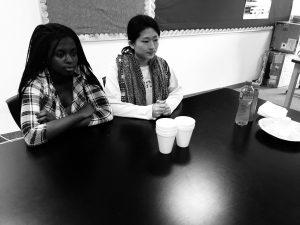
This photo mimicked the strategies that were used for lunch counter sit-ins in 1960s. The participants were mainly students, and it was part of the principles to not to bear any arms or weapons. Despite the student’s non-aggressive attitudes, they were not served any foods or drinks by the cafeteria or the lunch counter. To create a setting that represents the lunch counter, I had to place few empty cups and some bottle of drinks along with a plate to show how the table is supposed to serve refreshments and snacks. I asked my classmate to not to put any facial expressions on our face. Since this photo captures the early stages of sit-ins movement, there are no people attacking the students in the photo. This movement was a very first attempt to stand against the segregation in lunch counter with specific organisation in the history of the United States. It shows the people’s responses in the public to this action by eliminating the presence of other humans in the surroundings. Jessica helped me remember that our faces should not be tilted by facing straight in the air. Our posture was significant in defying against the social injustice that had been harming not only the rights of African-Americans but also their dignity.
Hi Hiromi,
The first thing that struck me in your picture was the clear body language that both of you were showing, which you effectively analysed. I was initially surprised that there were no attackers present; I therefore enjoyed your explanation of this in your post all the more, and thought it was great how you constructed your post to convey this detail only at the end. There really isn’t anything negative to point out from my perspective, but I thought that possible you could have chosen to take an image a little less coherent with one specific event in the civil rights movement and combined multiple elements.
-Kasimir
Hi Hiromi.
I really enjoyed reading the explanation behind your blog post. I think that it was extremely smart to have the characters in the photo have their heads raised high in order to portray the message of strength and resilience in the face of oppression, which is something that I would not and did not think about including in my own photo. I also like how you have people of different races protesting, as it shows the diverse nature of the civil rights movement.
I would like to ask why you decided not to include any people attacking the protestors. I feel like that image is one of the most memorable parts of the sit-ins. Was it to show a different side of the experience, or is there another reason?
Overall, the scene looks and feels realistic, and I think that you have done a really great job with this photograph.
Cire
So do you and Jessica symbolize the youth? Or are you just both advocating to end segregation within restaurants, lunch counters, etc? I believe this connects mostly to the SNCC as you mentioned students, which you could have incorporated a little more in your explanation of your picture to add some context and connect it back further to the Civil Rights. However your analysis of the picture does portray the resolute and determined character of those fighting this cause. Was it only or mostly students who participated in these sit-ins to promote equality and fight discriminiation? I think a little more historical context and background of some general knowledge will add even more to your photograph and post as a whole. Overall great picture and good job!
Hiromi,
Good representation of the beginning of the sit-ins. You did a good job keeping a straight face to show the seriousness of the situation and the potential anxiety that participants felt at the time. The empty cups clearly shows how these participants were treated. However, I wonder if both people in the picture are participating in the sit-ins. Maybe you could show the treatment of a white person in comparison to that of a black person in the same setting to clearly show the unfair treatment the latter were experiencing. Good job.
— Tidiane D.